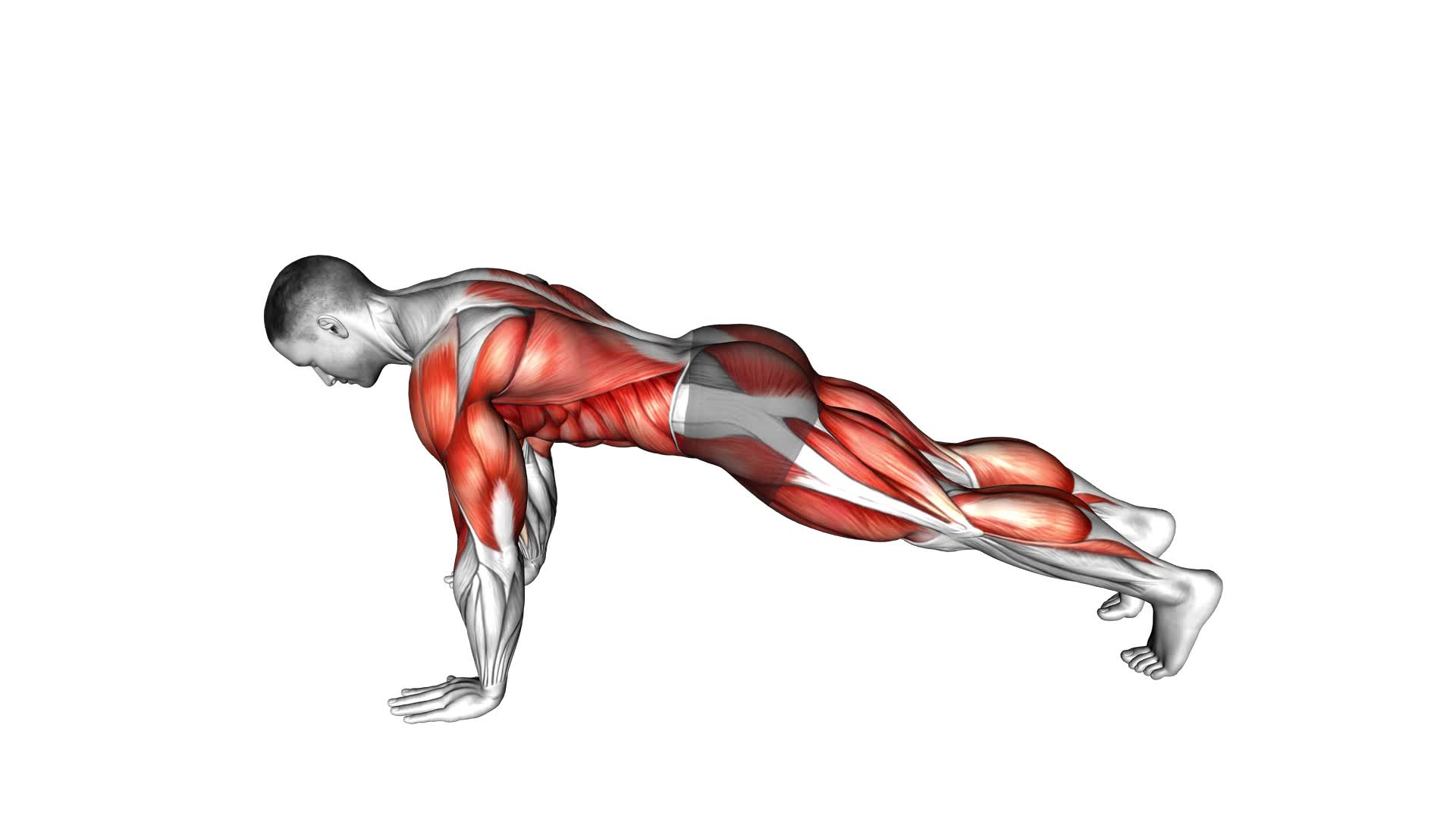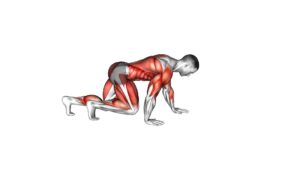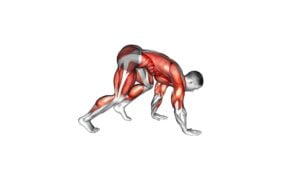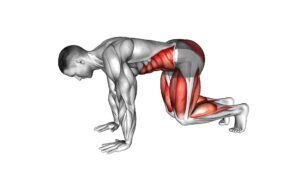Bear Walk (male) – Video Exercise Guide & Tips

Looking to add a challenging exercise to your routine? Check out the Bear Walk!
Watch This Exercise Video
This video exercise guide and tips will help you master the proper form and technique. You'll also discover modifications and progressions to keep you motivated.
Avoid common mistakes and get ready to feel the burn with this full-body workout.
Watch the video and start incorporating the Bear Walk into your fitness routine today!
Key Takeaways
- The Bear Walk activates multiple muscles in the body.
- Proper form and technique, such as engaging core muscles and maintaining a neutral spine, are important for maximizing the benefits and preventing injuries.
- Modifications and progressions, such as trying the single-leg Bear Walk or Bear Crawl Push-Ups, can increase the challenge and target specific muscle groups.
- Common mistakes to avoid include rounding the back, lifting hips too high, and rushing the movement, as proper technique is crucial for optimal results and injury prevention.
Benefits of the Bear Walk
To experience the benefits of the Bear Walk, you can challenge your core and upper body strength by performing this exercise regularly. The Bear Walk is a highly effective exercise that activates multiple muscles in your body. As you move on all fours, your shoulders, arms, and upper back muscles are engaged, helping to build strength and stability in these areas. The exercise also targets your core muscles, including the abs, obliques, and lower back, which are essential for maintaining good posture and stability.
One of the key benefits of the Bear Walk is its ability to improve balance and coordination. By relying on your arms and legs for support while keeping your body low to the ground, you're forced to engage your core and maintain stability. This not only enhances your balance but also improves your overall coordination. As you practice the Bear Walk, you'll become more adept at coordinating the movement of your arms and legs, leading to better motor control and body awareness.
Incorporating the Bear Walk into your fitness routine can provide a challenging and effective way to strengthen your core and upper body muscles. Additionally, the exercise can improve your balance and coordination, making it a valuable addition to any workout regimen.
Proper Form and Technique
To perform the Bear Walk with proper form and technique, you should focus on maintaining a strong and stable core while engaging your upper body muscles. Here are some tips to help you improve your stability and adapt the exercise to different fitness levels:
- Keep your core muscles engaged throughout the movement to provide stability and prevent your back from sagging.
- Maintain a neutral spine by avoiding excessive arching or rounding of your back.
- Keep your shoulders down and away from your ears to avoid unnecessary tension in your upper body.
By following these guidelines, you can ensure that you're performing the Bear Walk correctly and maximizing its benefits. Remember, proper form and technique are essential to prevent injuries and get the most out of your workout.
Transitioning to the next section about modifications and progressions, you can explore different variations of the Bear Walk to challenge yourself and continue progressing in your fitness journey.
Modifications and Progressions
Now let's explore some modifications and progressions to challenge yourself and continue progressing in your fitness journey with the Bear Walk.
To take your Bear Walk to the next level, you can try advanced variations that will further engage your muscles and increase the intensity of the exercise. One modification you can try is the single-leg Bear Walk, where you lift one leg off the ground while maintaining a stable and controlled movement. This variation adds an extra challenge to your core and stability muscles.
Another advanced variation is the Bear Crawl Push-Up, where you perform a push-up during each step of the bear walk. This modification targets your upper body muscles, particularly your chest, shoulders, and triceps.
When progressing in your fitness journey, it's essential to prioritize injury prevention strategies. To reduce the risk of injury during the Bear Walk, make sure to maintain proper form and technique. Keep your core engaged, your back straight, and your shoulders stable throughout the exercise.
It's also essential to listen to your body and not push yourself beyond your limits. Start with the basic Bear Walk and gradually increase the intensity and difficulty as your strength and stability improve.
Remember to always warm up before attempting any advanced variations and consult with a fitness professional if you have any concerns or questions.
Common Mistakes to Avoid
Avoid these common mistakes when performing the Bear Walk exercise. To ensure that you're getting the most out of this exercise and reducing the risk of injury, it's important to maintain proper technique. Here are some common mistakes to watch out for:
- Rounding your back: One common mistake is allowing your back to round during the Bear Walk. This puts unnecessary strain on your spine and can lead to back pain. Focus on keeping your back straight throughout the movement.
- Lifting your hips too high: Another mistake to avoid is lifting your hips too high. This takes the emphasis off of your core and places more strain on your shoulders. Keep your hips in line with your shoulders to maintain proper form.
- Rushing the movement: It's important to perform the Bear Walk exercise with control and precision. Avoid rushing through the movement, as this can lead to sloppy form and increased risk of injury. Take your time and focus on engaging the correct muscles.
Sample Bear Walk Workout
Maintain proper technique and challenge your muscles with this sample Bear Walk workout. The Bear Walk is a versatile exercise that can be modified to target different muscle groups and increase the intensity of your workout. By incorporating bear walk variations into your routine, you can engage your core, shoulders, arms, and legs for a full-body workout.
Start with the basic Bear Walk: Get into a plank position with your hands directly under your shoulders and your knees hovering just above the ground. Begin by moving your right hand and left foot forward simultaneously, followed by your left hand and right foot. Keep your core engaged and your back straight as you move forward. Repeat for a set distance or time.
To add variety and challenge to your workout, try different bear walk variations. Some examples include the Bear Crawl, where you move forward and backward in a crawling motion, and the Bear Walk with Shoulder Taps, where you touch your opposite shoulder with your hand while in the bear walk position.
The benefits of bodyweight exercises, like the Bear Walk, are numerous. They can improve strength, stability, and mobility without the need for expensive equipment or a gym membership. Plus, they can be done anywhere, making them a convenient option for busy individuals.
Incorporate this sample Bear Walk workout into your routine to strengthen your entire body and reap the benefits of bodyweight exercises.
Frequently Asked Questions
How Many Calories Can You Burn by Doing the Bear Walk Exercise?
You can burn a significant amount of calories by doing the bear walk exercise.
Bear walk variations, such as adding weights or increasing the speed, can make it even more effective for weight loss.
This exercise engages multiple muscle groups and increases your heart rate, resulting in a higher calorie burn.
Incorporating the bear walk into your fitness routine can help you achieve your weight loss goals and improve overall strength and endurance.
Can the Bear Walk Help Improve Overall Body Strength?
The bear walk is a great exercise for improving overall body strength. By incorporating bear walk variations into your workout routine, you can target different muscle groups and challenge your body in new ways.
The bear walk mainly works your core muscles, including your abs, lower back, and hip flexors. This exercise helps to enhance stability, balance, and coordination while also building strength in your upper body and lower body.
What Are Some Alternative Exercises That Can Be Done for Those Who Find the Bear Walk Too Challenging?
If the bear walk is too challenging for you, don't worry, there are alternative exercises that can help.
For beginners, you can try modified versions of the bear walk, such as bear crawl or crab walk. These exercises still target the same muscles while providing a bit more stability.
Another option is to focus on other bodyweight exercises that improve overall strength, like planks or push-ups.
Remember to listen to your body and start at a level that feels comfortable.
Is It Necessary to Warm up Before Performing the Bear Walk Exercise?
Before performing the bear walk exercise, it's important to warm up your body. Dynamic warm-ups help increase blood flow and prepare your muscles for the workout.
Stretching before exercise also helps improve flexibility and reduce the risk of injury.
So, to get the most out of your bear walk, make sure to include a warm-up routine that includes dynamic movements and stretching.
This will help you perform the exercise more effectively and safely.
Can the Bear Walk Exercise Be Beneficial for Individuals With Knee or Back Problems?
The bear walk exercise can be beneficial for individuals with knee or back problems. By modifying the bear walk, you can still engage your core and improve stability without putting too much strain on your knees or back.
This exercise helps strengthen your core muscles, increase shoulder and hip mobility, and improve overall stability.
However, it's always important to consult with a healthcare professional or a certified trainer before starting any new exercise routine, especially if you have existing knee or back issues.
Conclusion
In conclusion, the bear walk is an effective exercise that offers numerous benefits for your overall fitness. By engaging multiple muscle groups and promoting core stability, this exercise helps improve strength, endurance, and coordination.
Remember to maintain proper form and technique, and start with modifications if needed. Avoid common mistakes such as rounding your back or rushing through the movement.
Incorporate the bear walk into your workout routine for a challenging and rewarding full-body exercise.

Author
Years ago, the spark of my life’s passion ignited in my mind the moment I stepped into the local gym for the first time. The inaugural bead of perspiration, the initial endeavor, the very first surge of endorphins, and a sense of pride that washed over me post-workout marked the beginning of my deep-seated interest in strength sports, fitness, and sports nutrition. This very curiosity blossomed rapidly into a profound fascination, propelling me to earn a Master’s degree in Physical Education from the Academy of Physical Education in Krakow, followed by a Sports Manager diploma from the Jagiellonian University. My journey of growth led me to gain more specialized qualifications, such as being a certified personal trainer with a focus on sports dietetics, a lifeguard, and an instructor for wellness and corrective gymnastics. Theoretical knowledge paired seamlessly with practical experience, reinforcing my belief that the transformation of individuals under my guidance was also a reflection of my personal growth. This belief holds true even today. Each day, I strive to push the boundaries and explore new realms. These realms gently elevate me to greater heights. The unique combination of passion for my field and the continuous quest for growth fuels my drive to break new ground.







